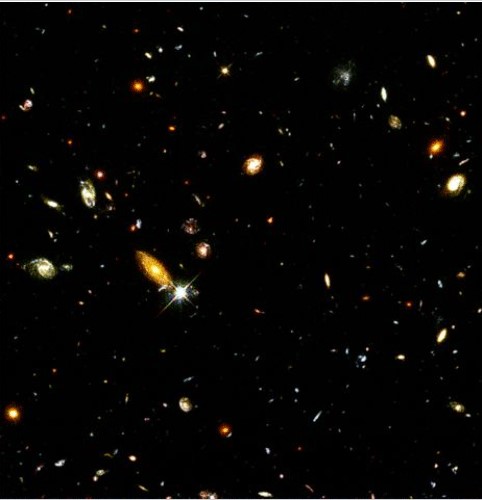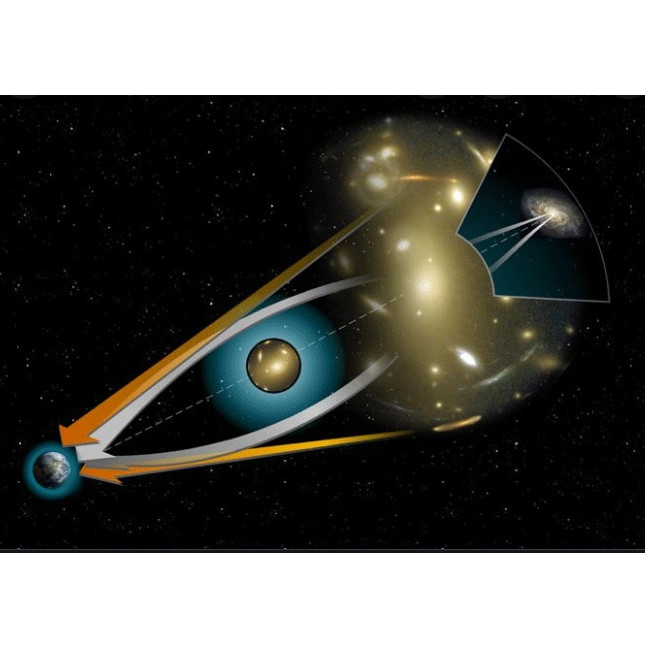Extra-Galactic Astronomy and Cosmology
 Extragalactic Astronomy is a branch of astronomy that is dealing with the study of objects not belonging to our galaxy. It is a relatively recent science, born after Edwin Hubble's discovery that Andromeda is a galaxy, similar to ours, located outside it. Subsequent studies showed that galaxies are not isolated but tend to group together forming the so-called Groups ofGalaxies, made up of dozens of galaxies, Clusters of galaxies made up of hundreds or thousands of components and Super Clusters of galaxies. More recently it has been shown that the large-scale structure of the Universe has a sponge-like structure, the empty parts of which are the so-called Voids, the surface is made up of Filaments formed by clusters of galaxies and Walls, one of the best known being the Great Wall. The enhancement of the telescopes has led to allow the observation of objects formed several hundred million years after the Big Bang and to make a distinction between extragalactic astronomy of distant and neighboring regions. Among the latter we have the Local Group, the objects located in distant regions are, for example, high redshift quasars. As far as cosmology is concerned, it is the science that has as its object of study the universe as a whole, of which it tries to explain in particular its origin and evolution.
Extragalactic Astronomy is a branch of astronomy that is dealing with the study of objects not belonging to our galaxy. It is a relatively recent science, born after Edwin Hubble's discovery that Andromeda is a galaxy, similar to ours, located outside it. Subsequent studies showed that galaxies are not isolated but tend to group together forming the so-called Groups ofGalaxies, made up of dozens of galaxies, Clusters of galaxies made up of hundreds or thousands of components and Super Clusters of galaxies. More recently it has been shown that the large-scale structure of the Universe has a sponge-like structure, the empty parts of which are the so-called Voids, the surface is made up of Filaments formed by clusters of galaxies and Walls, one of the best known being the Great Wall. The enhancement of the telescopes has led to allow the observation of objects formed several hundred million years after the Big Bang and to make a distinction between extragalactic astronomy of distant and neighboring regions. Among the latter we have the Local Group, the objects located in distant regions are, for example, high redshift quasars. As far as cosmology is concerned, it is the science that has as its object of study the universe as a whole, of which it tries to explain in particular its origin and evolution.
The dark universe: dark matter and dark energy

Faculty: Antonino Del Popolo
It is now known that the Universe we observe is made up only in small part, about 5% of baryon material, the remaining 95% is made up of matter of which we have almost no information: dark matter which constitutes about 27% of the mass-energy of the Universe and dark energy which constitutes about 68% of it. Dark matter is a hypothetical component of matter that does not emit electromagnetic radiation and would currently be detectable only indirectly through its gravitational effects. His revelation was attempted in different ways: a. direct detection, observing the recoil of the nucleus of a material interacting with dark matter; b. indirect detection, through the study of the decay products of dark matter; c. production in particle accelerators. Dark matter has never been revealed until today. Dark energy, on the other hand, is a hypothetical form of energy that is not directly detectable, spread homogeneously in space, which could justify, through a large negative pressure, the accelerated expansion of the universe. Its original discovery is linked to the emission of type Ia supernovae. Despite the many hypotheses, to date it is not known what dark energy consists of.
Primordial Universe
Faculty: Giuseppe Puglisi
Probing the cosmic microwave background (CMB) and cosmic inflation allows us to peer directly into the dawn of our Universe, deciphering clues imprinted in its earliest moments to understand its composition and evolution. Detailed study of anisotropies in the CMB offers a unique window into the primordial quantum fluctuations that triggered the formation of large cosmic structures, while inflation provides the theoretical framework to explain the observed homogeneity and isotropy. Understanding the mechanisms of inflation and the properties of the CMB not only answers fundamental questions about the origin and fate of our Universe, but also opens new frontiers in theoretical physics, with potential implications for the nature of spacetime and fundamental interactions.